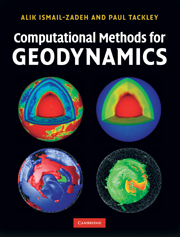Book contents
- Frontmatter
- Contents
- Foreword by Gerald Schubert
- Preface
- Acknowledgements
- 1 Basic concepts of computational geodynamics
- 2 Finite difference method
- 3 Finite volume method
- 4 Finite element method
- 5 Spectral methods
- 6 Numerical methods for solving linear algebraic equations
- 7 Numerical methods for solving ordinary and partial differential equations
- 8 Data assimilation methods
- 9 Parallel computing
- 10 Modelling of geodynamic problems
- Appendix A Definitions and relations from vector and matrix algebra
- Appendix B Spherical coordinates
- Appendix C Freely available geodynamic modelling codes
- References
- Author index
- Subject index
- Plates section
3 - Finite volume method
Published online by Cambridge University Press: 05 June 2012
- Frontmatter
- Contents
- Foreword by Gerald Schubert
- Preface
- Acknowledgements
- 1 Basic concepts of computational geodynamics
- 2 Finite difference method
- 3 Finite volume method
- 4 Finite element method
- 5 Spectral methods
- 6 Numerical methods for solving linear algebraic equations
- 7 Numerical methods for solving ordinary and partial differential equations
- 8 Data assimilation methods
- 9 Parallel computing
- 10 Modelling of geodynamic problems
- Appendix A Definitions and relations from vector and matrix algebra
- Appendix B Spherical coordinates
- Appendix C Freely available geodynamic modelling codes
- References
- Author index
- Subject index
- Plates section
Summary
Introduction
The finite volume (FV) method is commonly used in computational fluid dynamics and offers an intuitive and conservative way of discretising the governing equations in a manner that combines some of the advantages of finite difference and finite element methods. The general discretisation approach is to divide the domain into control volumes and integrate the equations over each control volume, with the divergence theorem used to turn some of the volume integrals into surface integrals. The resulting discretised equations equate fluxes across control volume faces (e.g. heat fluxes) to sources and sinks inside the volume (e.g. changes in temperature), and can be solved with standard direct or iterative methods (Chapter 6). The finite volume formulation is conservative because the flux flowing across a shared volume face is the same for each adjoining volume, and this is an important property in some applications. The method can be used with unstructured grids, although this chapter focuses mainly on rectangular grids, on which the discretised equations become very similar to finite difference equations. For implementation details related to using unstructured grids the reader is referred to Versteeg and Malalasekera (2007).
Grids and control volumes: structured and unstructured grids
Each control volume contains a node on which scalar quantities are defined. For a simple, rectangular structured grid the node is straightforwardly located in the control volume centre, as indicated by the example in Fig. 3.1.
Information
- Type
- Chapter
- Information
- Computational Methods for Geodynamics , pp. 43 - 62Publisher: Cambridge University PressPrint publication year: 2010
